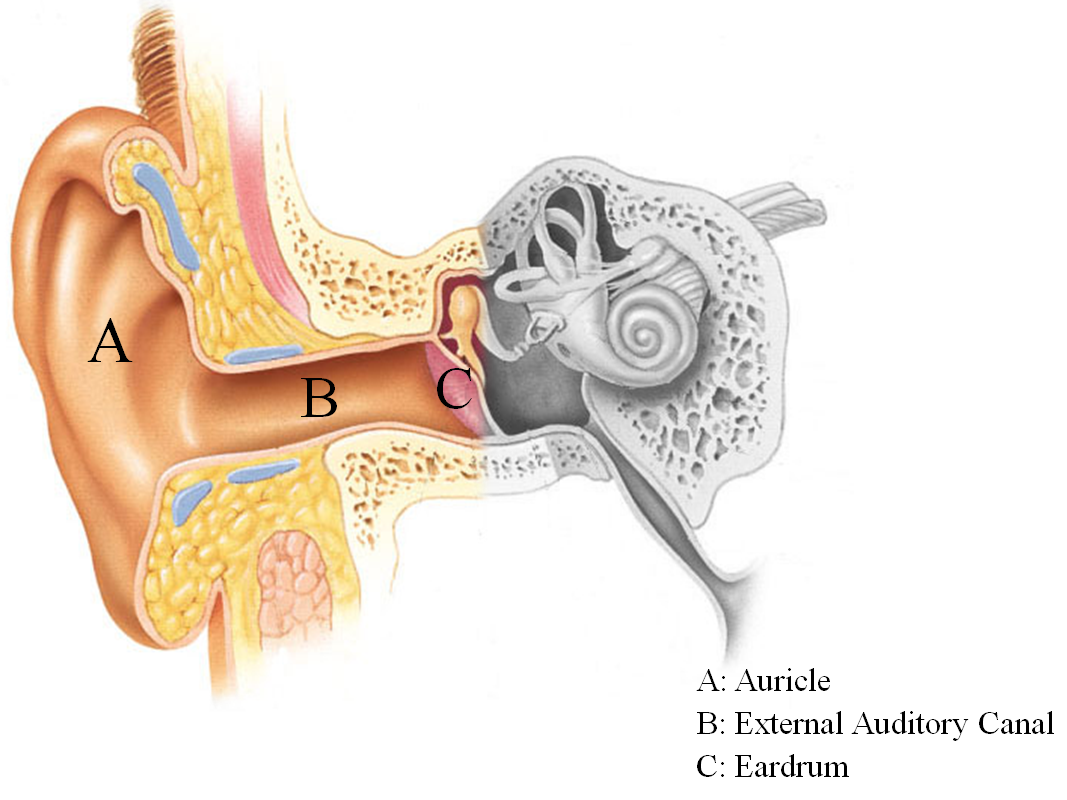Hearing is the ability of the brain to receive and process sounds around us! The ear is an amazing organ that collects sound waves in the air and transforms them into neural pulses to be sent to the brain where they are processed in order for hearing to happen. Normal hearing requires normal function of the ear, the neural pathways, and the brain. Any deficit that might happen at any point along the auditory system might lead to a hearing impairment.
The ear can perceive sounds from barely audible to very loud. The loudness of sound is measured in units called decibels, abbreviated as “dB”. A decibel unit expresses the relative intensity of sounds on a scale from zero up to around 120 dB. Normal speech occurs around 60 to 65 dB and most people find sound as loud as 100dB to be uncomfortably loud.

The outer ear consists of the auricle, the external auditory canal, and the external surface of the eardrum. The sound waves are collected by the auricle and directed into the external auditory canal to reach the eardrum.
The eardrum is a very thin flexible membrane that separates the outer ear from the middle ear space. The eardrum acts like a diaphragm of a microphone. When the sound wave strikes the eardrum, it causes it to vibrate in order to transfer the sound energy to the middle ear.

The middle ear is an air-filled space. It is separated from the outer ear by the eardrum. In the middle ear there are three tiny bones: the malleus (hammer), incus (anvil) and stapes (stirrup). These bones are connected to each other as a chain that is called the ossicular chain. This chain starts at the malleus that is attached to the inner side of the eardrum, and ends at the stapes that is connected to another membrane at the entrance of the inner ear that is called the oval window.
The sound wave reaching the eardrum causes it to vibrate. This vibration is transmitted through the malleus, incus and stapes to reach the oval window. The interaction of the middle ear components amplifies the sound vibrations further before they are relayed fully into the inner ear via the oval window.

The inner ear includes the hearing organ as well as the balance organ. The hearing organ is referred to as the cochlea. The cochlea is similar in shape to a snail shell. It is formed from a bony capsule that contains several fluid filled membranous sections. The main three membranous compartments are: the vestibular canal, the medial canal, and the tympanic canal.
Along the cochlear canal there is a very sensitive sensory structure called the “organ of corti”. This structure has many different types of cells. However, two types of them are very critical to hearing: the outer hair cells and the inner hair cells. These cells contain hair-like structures at the top of each cell.
When the sound waves cause the oval window vibrate, the fluid inside the cochlea moves. This causes the hair-like structures to move. This motion activates the hair cells to transform the vibrations into electrical impulses that can travel via the auditory nerve and the central nervous system to the brain.

Normal hearing function requires both ears to be involved in the hearing process. Both ears act together integrally and the input from both ears is very important for the brain to process the sound appropriately. Hearing with both ears adds many advantages over hearing with a single ear:
- Both ears provide louder input to the brain. This is called “the summation effect”.
- Both ears provide much better speech understanding especially in the presence of background noise. This happens because the brain can discriminate better between speech and noise when it receives input from both ears.
- Both ears are very important for the brain to handle noise appropriately and reduce its annoying effect.
- Both ears are very important for sound localization around us. This happens by the ability of the brain to analyze the time and intensity cues that are perceived at both ears.
- The brain needs continuous stimulation from both ears to maintain normal processing and prevent neural deprivation over time.
- It’s been proven that two ears provide much better 3-dimentional sound quality perception, which is very important for estimating the distance between the listener and the sound source.
Simply, hearing with both ears provides better hearing and better sound quality. Our ability to hear with both ears is what makes us appreciate music, identify near sounds from far sounds, and be able to handle a conversation in a noisy environment.
